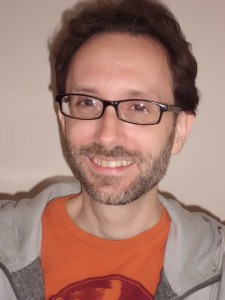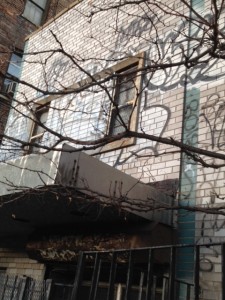By Samina Shahidi
I met Paul (Pinny) Bulman through an informal network of poets who have won the BRIO (the Bronx Recognizes Its Own) award and to whom I belong. This organization is sponsored by the Bronx Council of Arts. BRIO winners are respectively granted fellowships, community projects and monetary awards for chosen manuscripts and other forms. Bulman received the 2014 BRIO for his collection of poems entitled old shul.
His work, he writes in the companion essay to this submission, explores the communities that had once inhabited “the original grand synagogue, which stood for more than 50 years on 161st Street and Amsterdam Avenue… torn down in 1971”, to the shul of 179th and Pinehurst Avenue as Latino communities began establishing themselves in Washington Heights. The 179th Street and Pinehurst synagogue also closed some years ago. In an email interview, Bulman explained that the “’Bridge Shul’ congregation relocated for the time being to the lower level of a different synagogue called Mt. Sinai on 187th Street”.
I sat in the audience of the “Bridge Shul” community for Bulman’s reading of this work in December 2014. It was an extraordinary discussion that connected both fragmenting and regenerating histories of family, ethnic and urban communities. His audience included Latina and African American residents and shul members who shared their memories of his father as a respected poet and community leader who worked in the insurance field. Bulman recalled walking through Washington Heights and watching his father often stopping to talk with and help the homeless men and women of the neighborhood, and other examples of his commitment to both his shul and greater community.
Bulman continues the activism of his father through his own professional and creative engagement; he has a doctoral degree in psychology, and works with children in the nonprofit mental health organization Astor Services for Children and Families. Although old shul is noted as reflection on loss, dislocation, and re-purposed sacred spaces, it also speaks, through startling, image-driven lines, to the waves of immigrant communities that move through cities and accrete in urban culture through symbol. The pictures accompanying Bulman’s essay demonstrate these moments of urban Jewish American history, worship and their place in our interior landscapes and collective visual language. – Samina
__________________________________________________________________
Companion essay to old shul: shadows and deconsecration by Paul (Pinny) Bulman:
For a number of years, I have been writing a series of poems entitled old shul. The word “shul” is Yiddish and refers to a synagogue, a Jewish house of prayer. Growing up within an Orthodox Jewish community in Washington Heights, our lives revolved around our shul, both personally and collectively. We often attended services at our shul several times daily. It was place where the community came together to celebrate holidays and lifecycle events. A space in which we supported one another during times of sorrow, bereavement, and loss. But where is one to go, what is one to do, when the loss one needs to mourn is that of the shul itself? When a shul dies, what happens to the remnant of community that survives it? Where do the memories from years past go to reside? Can a sacred space ever cease being sacred?
The old shul I attended in my childhood, the Washington Heights Congregation, lasted many years longer than anyone was predicting, even as so many other shuls did not. By the time I was born in 1974, the demographics of the Bronx and Upper Manhattan had been shifting for years. Once vibrant Jewish communities were vanishing or completely gone, the victims of white flight and urban inner-city neglect. Often, the only hints of the communities that once existed were the small discolored rectangular patches on the sides of apartment doorways where Mezuzahs were once kissed, and the remnants of the old shuls. Many of these centers of Jewish life and worship were torn or burnt down, but some were still visible as crumbling graffiti-ed shells of buildings or as a lone Star of David on the side of a supermarket or church.
The shul I attended had already gone through this process once before I was born. I was never able to experience the original grand synagogue, which stood for more than 50 years on 161st Street and Amsterdam Avenue. That shul was torn down in 1971. The remnants of the community retreated north to a smaller shul on 179th Street and Pinehurst Avenue. It was located next to the entrance ramp of the George Washington Bridge, which is how it earned its nickname, “The Bridge Shul.” When I was very young, the Jewish community in the area was large enough that the shul still drew a crowd, especially on the High Holidays. But throughout my childhood, the Jews left the neighborhood in droves, headed for suburbia or Israel. For as far back as I can remember, people used the word “dying” to describe our community and our shul, while the neighborhood became a vibrant, largely Dominican community. The recent gentrification and revitalization of the Jewish community in the neighborhood was not enough to save the shul, which closed its doors for the final time in the spring of 2014.
The poems in the old shul series I’ve been writing grapple in various ways with the questions posed above. While many of these poems incorporate imagery and memories specific to my childhood and the old shuls of Washington Heights, the themes of transition, dislocation, and loss running through the series are not specific to my life or any one neighborhood. These phenomena are nothing new and have always been an integral part of Jewish history and human history. The world is full of the remnants of communities that thrived and then died or moved on. It is full of sacred spaces abandoned or destroyed; many forgotten, even as new ones are continually created. In this series of poems, I try to weave together these strands of the personal, historical, and universal, to create a new sacred space of words; a space of memory and mourning; a space of renewal and rebirth.

old shul: shadows
as the evening prayers cast
shadows on stained plastic windows
we godspeak to the rhythm
of backfiring buses
and the strains of merengue
from the neighboring building
to which half the empty room
is subconsciously swaying
on leaving we
steady ourselves
by the side fence
voices mute with exile
as the rats find shelter
stuffing themselves into cracks
like prayer notes
and a little girl
hoists herself
up onto the fence bars
pointing to
the color topped needles
scattered like toys
suddenly left.
old shul: deconsecration
there is no
shofar blown
no candles lit
there are no
elaborate ceremonies of
holy objects shaken or paraded
no ancient prayers read backwards
in mournful melody
one day it just
ends
and the next time
i return
the star of david is semi-
obscured by a sign advertising a
sale on platanos
and the ghostly discoloration
of hebrew lettering removed
from above the
front entrance now
overlooks a gaptoothed
woman behind a stained card table
loudly selling
packs of men’s underwear
for a peso.
(Editor’s note: The poem deconsecration was previously published in Poetica as a winner of the ADR Poetry Award.)






Comments
1 response to ““A New Sacred Space of Words”: old shul poems and essay by Paul (Pinny) Bulman”
Wonderful essay and poetry. So meaningful.